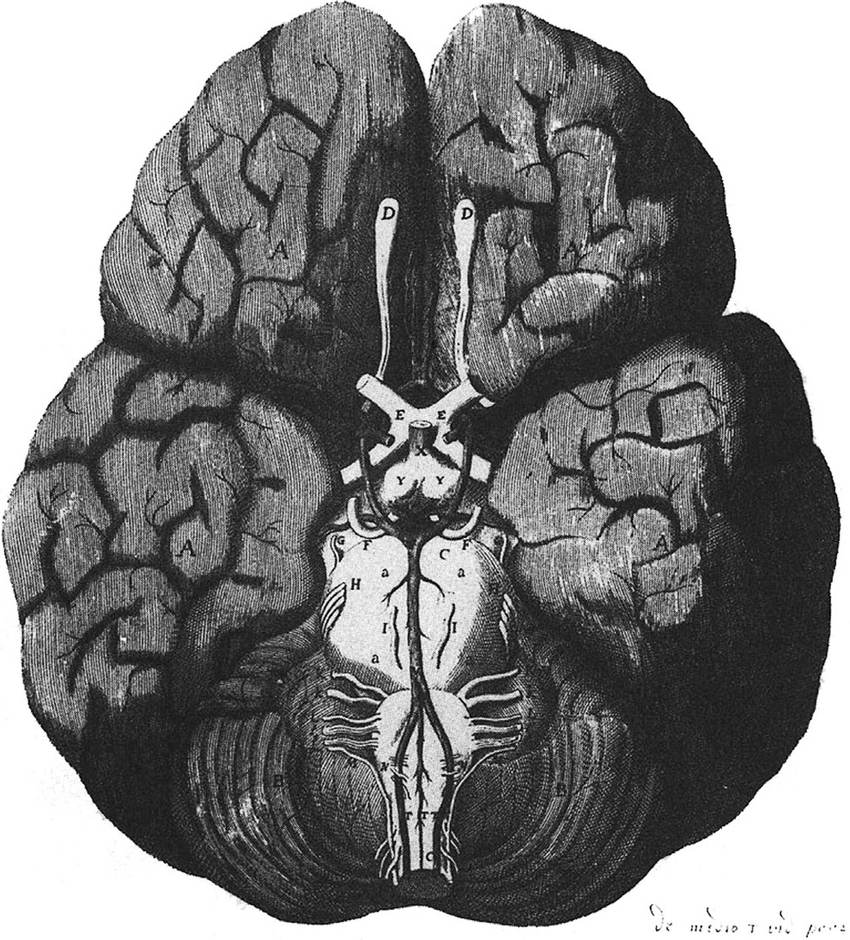
“The form of heaven is astounding and completely mind-boggling, because it far surpasses any concept of forms we can possibly develop by looking at worldly objects, even when we analyze them. All heavenly communities are organized into that form, and amazing to say, they exhibit a circular motion that accords with it, though angels and spirits do not feel the motion. The situation resembles the earth’s daily rotation on its axis and its annual revolution around the sun, which the inhabitants do not sense.
I was shown what the form of heaven is like in its lowest realm; it resembled the pattern of folds seen in human brains. A perceptible view of its flow or circular motion was granted to me, the demonstration lasting several days.
From this experience I could tell that the form of the brain matches the pattern of movement in heaven. The deeper parts of the brain, invisible to the eye, match the deeper structures of heaven, which are totally incomprehensible. The angels said this shows that we were created to reflect the structure of the three heavens. So the image of heaven is imprinted on us in such a perfect way that we are a miniature heaven at its smallest scale, which is why we have a correspondence with the heavens. “
-Emanuel Swedenborg, Secrets of Heaven §4041

I’ve been thinking a lot recently about what it means to become the New Church. This is a point of great debate and discourse within the Swedenborgian community and has been since the beginning. Is it a denomination, a heavenly society, a vibe? One of the ways that Swedenborg describes the new church is as “a crown for all the churches.” He employs the allegory of Nebuchadnezzar’s dream to illustrate this progression of spiritual states from the crude matter that makes up the legs to the gold that makes up the head.
What is a crown? An ornament, worn on the head, which signifies authority, usually of some kind of monarch. Today we are talking about another sort of crown, one that everyone can wear.
The brain has been deeply mysterious, throughout most of history. This is largely due to its fragility and its concealment. This one is made of plastic, but the one inside my skull, and yours, has the texture of silken tofu. This means that, for most of human history, these deep, delicate gyres and folds were thought to be worthless. The Ancient Egyptians discarded the brain when preserving the body. And up to Rene Descartes, the cerebrum itself was thought to be nothing more than space filler.
Of course we think very differently today, the idea that the brain is an organ of cognition is no longer controversial and is considered common knowledge. But just like one cannot scientifically measure a drum, or a piano, to find music, one cannot find the music of consciousness by simply subjecting the brain to analysis. But we can see the evidence of it, just like the written word is evidence of the consciousness of the writer.
And this idea, that there is something anatomical which moderates the influx of consciousness so perfectly as to account for all of human thought and behavior, this is a theological proposition. Influx, says Swedenborg, is according to the state of the receiving vessel.
The suggestion, which Swedenborg was arguing against, that is brought to us through the lens of Cartesian duality is; that the soul, and all the ways that it is judged as good or evil, saved or dammed, blissful or suggering, is beyond the grasp of the scientific mind, is a theological proposition. It proposes that the mechanisms of spiritual realities are beyond our grasp as individuals. That, apart from the intervention of ecclesiastical authority we are spiritually helpless.
This is the first paradigm that Swedenborg had to face, way back in his 30s when he was still begging the king of Sweden for a job, he writes about “tremulations as fast as lightning” which bring animation to the brain and the nervous system.
To Descartes, the brain was a whirlpool, connected to the soul through a tether at the pineal gland, but Swedenborg proposes another kind of logarithm. He sparks a revolution. He says that the spiraling geometry of the energetic motion of the brain is continuing on a path where center and edge become entangled. To the old way of thinking heaven was somewhere far away, somewhere ruled by church patriarchs, with lists and gates and qualifications and a dress code. To Swedenborg, it’s a state of mind, and states of mind are a combination of spiritual influx and physiological, anatomical reception. There is a co-respondence a “responding together” between the natural and the spiritual. Heaven exists in the brain in the way that meaning exists in text.
Something changed, about a quarter millennium ago, and it changed in the most fundamental, scientific levels of our thinking. Suddenly we were here, we were given permission, that our interoceptive awareness of ourselves might actually connect to something that we can understand as part of ourselves. Our internals become open and accessible, and we started naming our thoughts in new ways, we started questioning authority, started revolutions, developed psychoanalysis, became aware of the class struggle, we stated changing and evolving radically because suddenly we were in direct, conscious possession of our own minds without the intervention of a church authority.
Cerebral interoception. Direct awareness of the living activity of ones own nervous system. This, days-long experience that Swedenborg describes of the churning motion of the heavens inside his own brain – I believe that it started to happen collectively.
It is a dangerous thing, to give the mind control of itself. Freedom is scary. If we are free then we are free to self destruct, to reinvent ourselves, to redefine humanity.
If you ask me what the brain does, I will tell you that it is the organ which processes time. It is self-editing and self-inhibiting within its own lifespan. It tells its own story to itself. This means that the way that our brains develop is what we call epigenetic – rather than following a strict genetic blueprint, they react and change to the environment, to trauma and comfort. That means that our brains are collective organs. They tell our collective story. Throughout all of history, the realest story, really, the only scripture, has been written in the language of neurons. Time, like the hand of God passes through us in a waveform, and the only evidence is the rippling spark of awareness flashing backwards at eternity, echoing the song of the universe, I am.
And the New Church, is just a story, not an inevitability, just a story we tell ourselves. A fairy tale. But it’s a good story, if we can finish it, it is a story that helps us become something new, revolutionize, rewire, undermine authority and reconnect to God. But it is not enough to recognize truth alone, is it, there is a great becoming, a bridge to cross. It will take courage and care to become real, and many may not like reality when they find it.
When we hear music, we tend to fall into the same neural networks as the musician. When we hold our children, we create mirrored connectome harmonics. “In a perfect and perpetual spiral the center is the edge and the edge is the center.” The new church is here, the new church is now, the new church is real, it is alive, or it is nothing.

Eleanor Schnarr, artist, mystic, poet and theologian, is the field intern at the Cambridge Swedenborg Chapel. An accomplished artist and writer, she has taken clerical initiation in the Saiva Siddhanta Hindu sampradaya and is on the path towards ordination in the Swedenborgian Church of North America. Her ministry and creative practice revolves around the teaching and development of the ‘Sacred Systems of Interoception’ across wisdom traditions from around the world, Systems which serve as tools to open up the interior senses and connect us with a higher reality. Through her work with the Swedenborg Chapel, she will be offering a series of sermons which will explore more of these deeply human ideas and practices in the coming months.